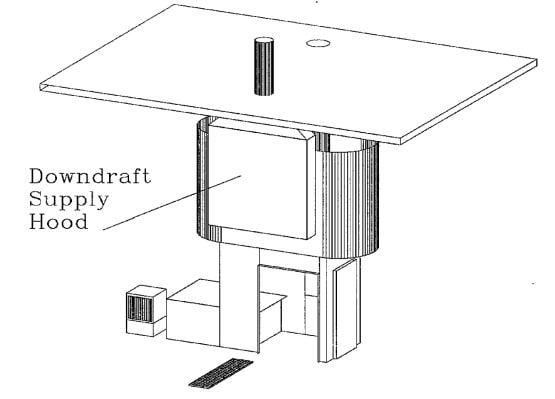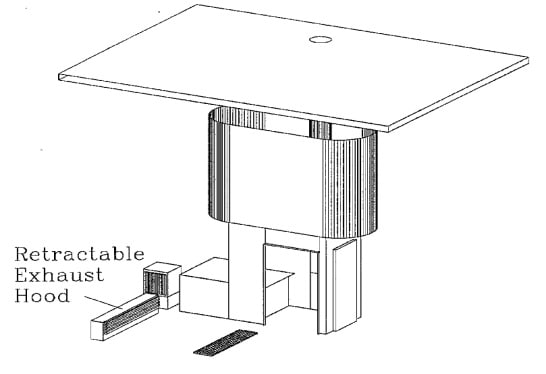Engineering Controls Database
Border Agents Exposure to Carbon Monoxide (CO) from Vehicle Emissions
| Border Control Agents may be exposed to harmful levels of Carbon Monoxide gas while working at a car inspection area at a federal border crossing. Many cars pass through the border crossing every day. Most are stopped with their engines idling during inspection, emitting car exhaust which contains carbon monoxide gas. | |
|
CO is a poisonous gas that is produced during combustion and is commonly found in engine exhaust. It is one of many chemicals found in engine exhaust resulting from incomplete combustion. Because CO is a colorless, odorless, tasteless gas, it can overcome the exposed person without warning. Symptoms: Initial symptoms of CO poisoning are headache, dizziness, drowsiness, or nausea. Advanced symptoms include vomiting, loss of consciousness, and collapse and coma or death, and can occur under continued or severe exposures to the gas. Young or elderly individuals, people with lung or heart disease, physically active people, and those at high altitudes may experience a faster progression of symptoms or an earlier onset of advanced symptoms when exposed to harmful levels of CO. Exposure Criteria: Exposure limits have been established for CO by NIOSH, the American Conference of Governmental Industrial Hygienists (ACGIH), and the Occupational Safety and Health Administration (OSHA). The NIOSH Recommended Exposure Limit (REL) for occupational exposures to CO gas in air is 35 ppm for full shift time-weighted average (TWA) exposure, and the ceiling limit of 200 ppm should never be exceeded. NIOSH has also determined that 1200 ppm is immediately dangerous to life or health (IDLH). In addition, 8-hour time weighted average concentrations of 25 and 50 parts per million (ppm) have been established by ACGIH and OSHA, respectively. |
|
|
Administrative Controls: (Especially recommended for Canine Enforcement Agents and other roving border agents due to the mobile nature of their duties) Rotation Schedule Mobile officers such as Canine Enforcement Officers and roving border agents are exposed to varying levels of CO gas while inspecting hundreds of cars per day that are giving off engine exhaust. Since these workers perform their duties outside, there are few options for preventing their exposure to CO other than limiting their duration of time in traffic where they are exposed to CO gas. A rotation schedule of 30 minutes in traffic and 30 minutes out of traffic is used at the San Yisidro border crossing between San Diego and Tijuana. A rotation schedule similar to San Yisidro’s may be useful in lessening exposure to CO emissions from car engine exhaust. However, it is important to tailor the rotation schedules to each crossing as each crossing may have different levels of CO exposure to its agents due to unique structural, traffic, and environmental conditions. Carbon Monoxide Monitors Usage of wearable carbon monoxide monitors can determine the extent of CO exposure in real time. The monitor can sound an alarm if CO concentrations reach levels higher than a set safety limit, alerting the agent who can then move to a safer area or instruct motorists to turn off their car’s engines. Furthermore the monitors can log and store data regarding an agent’s daily exposure to CO. This data can be used to design or alter a rotation schedule that effectively maintains safe levels of CO exposure. Since every border crossing has different conditions for CO exposure and conditions can vary based on traffic volume or environmental conditions such as weather, CO monitors can be very useful in protecting agents from abnormally high concentrations of CO and determine in which conditions CO levels are likely to be higher or lower. Vehicle Free Buffer Zone A vehicle free buffer zone is created in front of the border inspection stations to make space between vehicles giving off exhaust and the border inspection workers. With this buffer space, ambient wind is better able to dilute and evacuate the exhaust emitted into the air and lower concentrations of CO in the surrounding area. If room is available, it may be useful to create an “on-deck” system where the majority of cars are held further back and a few cars next in line wait at a stop before the inspection zone. This allows those cars waiting next in line to be patrolled by the roving border agents before entering the inspection zone. Protocol for Poorly Maintained Vehicles There are many poorly maintained vehicles, giving off excessive amounts of exhaust that pass through the border crossing on a daily basis. Poorly maintained vehicles can emit exhaust not only from the tailpipe, but also from the engine and sides of the vehicle. A protocol for poorly maintained vehicles or “smoker” vehicles should be developed. These cars could be channeled to an outside lane and required to shut down their engines during inspection. Pre-Primary Inspections Pre-primary inspections began to occur due to the increased traffic levels at border crossings. These inspections put officers at increased risk of exposure to vehicle exhausts since they are not protected by a ventilated inspection booth. If these inspections are to continue, it is recommended that fixed workstations (booths) be installed that provide pre-primary inspection officers with protection from elevated temperatures and exposure to vehicle exhausts. Engineering Controls: Soffit Fans Flow Reversal The soffit fans exhaust air from the canopy area above the lanes. The direction of the air out of the canopy could be reversed so that air flows into the lanes/inspection area instead. The fans would draw less-contaminated air through a stack above the canopy/roof. To reverse the airflow, the soffit fans should be physically inverted, so that the fans push the air into the lane/inspection area. This would cause an increase in supply air that could help in diluting and moving air in the canopy area especially during stagnant wind/inversion conditions. Laminar Flow Booth Supply Laminar airflow is used to provide the border agent working in an inspection booth with an envelope of clean air around the worker and help prevent CO contaminated air from entering the booth. The booths require an optimized unidirectional airflow pattern free from turbulence. Clean air is supplied at the top of the booth, moves downward through the booth, and exhausts through the door or at vents at the bottom of the booth. In order to maintain the optimized airflow, air should be distributed at a low velocity and evenly at the supply. To achieve this, a laminar flow element should be installed at the booth ceiling and vents should be placed in the lower side of the booth to allow for air to exit. Vent location and size should be strategically selected to maximize the control efficiency. It is important to maintain positive pressure from inside the booth to the outside in order to prevent as much vehicle exhaust from entering the booth as possible. In addition, booth supply air should be provided from a clean source location and be free of air contaminants Supply Air at Car Exhaust Instead of attempting to exhaust vehicle emissions at inspection sites, supplying air aimed at the car exhaust would work to blow vehicle emissions away from the inspection sites and dilute its contaminants. The supply air would also have a greater reach when compared to exhaust systems even with similar airflow rates. An air supply jet would need to be installed in the areas of the inspection booth which are closest to the car exhaust. This option is expected to be effective; however, it should be tested before being fully implemented at any site. The effectiveness of this system could be evaluated using tracer gas or smoke visualization methods. Down Draft Air Shower (Figure 1) Air showers that supply air downwards outside of the inspection booths can help prevent CO and vehicle exhaust from moving into the general work area of the border agents. The air shower provides an envelope of clean air around the agent extending outside the booth. The use of the air shower may require high clearance vehicles to be routed through a special lane (or lanes) designed in order to prevent damage to the air supply plenum. This control option would also require the installation of additional ducting and fan system. The air shower control would require a higher capacity fan capable of providing an estimated additional airflow of 5000-10,000 cfm per booth.  Retractable Exhaust Capture Hood (Figure 2) A retractable exhaust capture hood positioned close to the tailpipe of cars idling at the inspection booth could be used to capture vehicle exhaust. When a car enters the inspection booth area and comes to a stop, a ventilation hood would pop up from the ground and begin to capture vehicle exhaust. The capture effectiveness of the exhaust would depend on how close the hood was to the tailpipe of the car. This option could also the use of the current ducting and air movement system employed by the pedestal and grate exhausts, but some reconfiguration would be required. When implementing this design, the variability in design of cars with respect to the location of the tailpipe would have to be taken into consideration when determining the location and size of the exhaust hoods.  |
|
| 010-02A; 010-03A; 171-33A; | |
|
Border Agents Border Agents Border Crossings Border Crossings Carbon Monoxide (CO) Carbon Monoxide (CO) Federal Security Federal Security Vehicle Emissions Vehicle Emissions |
|
|
Rotation Schedule: At the San Yisidro border crossing, a rotation schedule of agents working 30 minutes in traffic and then 30 minutes out of traffic maintains a time weighted average of less than 12.5 ppm CO exposure. This is half of the strictest occupational safety limit of 25 ppm of CO. Vehicle Free Buffer Zone: In general, the greater the separation of running cars from border agents, the greater the potential to reduce CO concentrations for workers. Down Draft Air Shower: Evaluations of the air shower as installed the Calexico and San Ysidro border crossings found that the system did not provide a significant added level of protection beyond the original ventilation system. This may be due to the air shower’s being placed too far above the lane although this was required for vehicle clearance. The air shower is expected to be more effective when it is closer to the worker. This system, however, did provide some protection to the workers as the CO concentrations in traffic 10 feet in front of the booth were significantly higher compared to directly outside the booth. |
